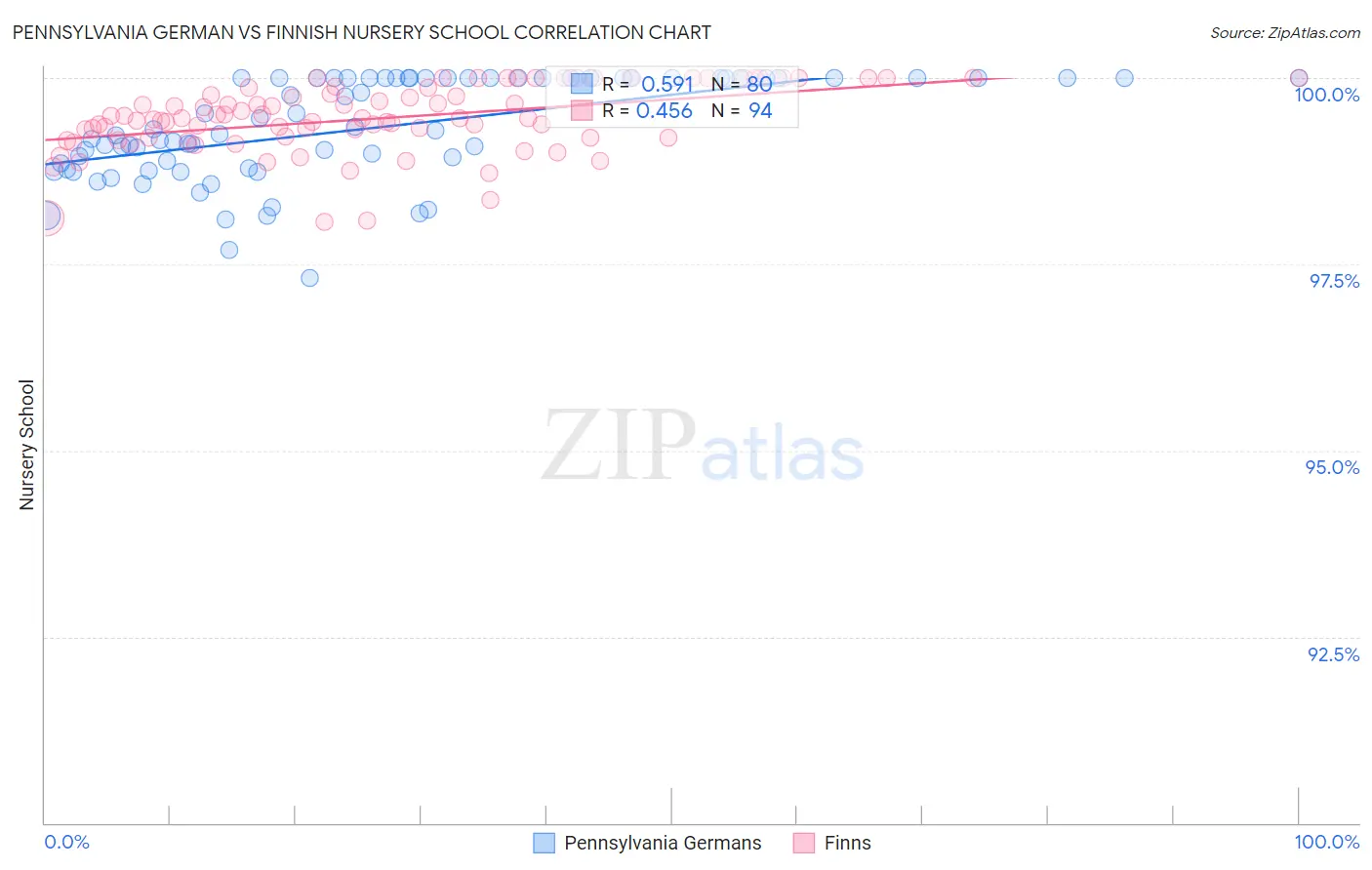Pennsylvania German vs Finnish Nursery School
COMPARE
Pennsylvania German
Finnish
Nursery School
Nursery School Comparison
Pennsylvania Germans
Finns
98.6%
NURSERY SCHOOL
100.0/ 100
METRIC RATING
20th/ 347
METRIC RANK
98.6%
NURSERY SCHOOL
100.0/ 100
METRIC RATING
21st/ 347
METRIC RANK
Pennsylvania German vs Finnish Nursery School Correlation Chart
The statistical analysis conducted on geographies consisting of 234,102,531 people shows a substantial positive correlation between the proportion of Pennsylvania Germans and percentage of population with at least nursery school education in the United States with a correlation coefficient (R) of 0.591 and weighted average of 98.6%. Similarly, the statistical analysis conducted on geographies consisting of 404,675,516 people shows a moderate positive correlation between the proportion of Finns and percentage of population with at least nursery school education in the United States with a correlation coefficient (R) of 0.456 and weighted average of 98.6%, a difference of 0.0%.

Nursery School Correlation Summary
| Measurement | Pennsylvania German | Finnish |
| Minimum | 97.3% | 98.1% |
| Maximum | 100.0% | 100.0% |
| Range | 2.7% | 1.9% |
| Mean | 99.3% | 99.5% |
| Median | 99.3% | 99.5% |
| Interquartile 25% (IQ1) | 98.8% | 99.2% |
| Interquartile 75% (IQ3) | 100.0% | 99.9% |
| Interquartile Range (IQR) | 1.2% | 0.67% |
| Standard Deviation (Sample) | 0.68% | 0.45% |
| Standard Deviation (Population) | 0.67% | 0.45% |
Demographics Similar to Pennsylvania Germans and Finns by Nursery School
In terms of nursery school, the demographic groups most similar to Pennsylvania Germans are Lithuanian (98.6%, a difference of 0.0%), Polish (98.6%, a difference of 0.0%), Danish (98.6%, a difference of 0.0%), Irish (98.6%, a difference of 0.010%), and Scotch-Irish (98.6%, a difference of 0.010%). Similarly, the demographic groups most similar to Finns are Lithuanian (98.6%, a difference of 0.0%), Polish (98.6%, a difference of 0.0%), Danish (98.6%, a difference of 0.0%), Scotch-Irish (98.6%, a difference of 0.0%), and Irish (98.6%, a difference of 0.010%).
| Demographics | Rating | Rank | Nursery School |
| Germans | 100.0 /100 | #10 | Exceptional 98.7% |
| Tlingit-Haida | 100.0 /100 | #11 | Exceptional 98.7% |
| Slovenes | 100.0 /100 | #12 | Exceptional 98.7% |
| English | 100.0 /100 | #13 | Exceptional 98.7% |
| Carpatho Rusyns | 100.0 /100 | #14 | Exceptional 98.7% |
| Swedes | 100.0 /100 | #15 | Exceptional 98.7% |
| Scottish | 100.0 /100 | #16 | Exceptional 98.7% |
| Aleuts | 100.0 /100 | #17 | Exceptional 98.7% |
| Dutch | 100.0 /100 | #18 | Exceptional 98.7% |
| Irish | 100.0 /100 | #19 | Exceptional 98.6% |
| Pennsylvania Germans | 100.0 /100 | #20 | Exceptional 98.6% |
| Finns | 100.0 /100 | #21 | Exceptional 98.6% |
| Lithuanians | 100.0 /100 | #22 | Exceptional 98.6% |
| Poles | 100.0 /100 | #23 | Exceptional 98.6% |
| Danes | 100.0 /100 | #24 | Exceptional 98.6% |
| Scotch-Irish | 100.0 /100 | #25 | Exceptional 98.6% |
| Sioux | 100.0 /100 | #26 | Exceptional 98.6% |
| Arapaho | 100.0 /100 | #27 | Exceptional 98.6% |
| Croatians | 100.0 /100 | #28 | Exceptional 98.6% |
| French | 100.0 /100 | #29 | Exceptional 98.6% |
| Europeans | 100.0 /100 | #30 | Exceptional 98.6% |